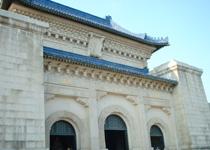
Nanjing's most famous landmark and a perennial favorite among tourists to Jiangsu, Zhongshan Ling is the grand tomb of Dr. Sun Yat-sen (also known as Sun Zhongshan).
Dr. Sun was the first president of the Republic of China and one of the leading organizers of the struggle to create a modern republic in China.
The impressive memorial was built in the 1920's. Its architecture is accentuated by its splendid natural setting on the forested slopes of Zijin Mountain on the outskirts of Nanjing, its buildings made of white stone with dark blue roof tiles. These are the colors of the Republic of China and they make a beautiful contrast with the green forest surrounding the monument.
Through the tripe archway at the entrance a long walkway leads through thick pine trees, with the grand staircase and tomb buildings in the distance. The memorial is desgned in a the shape of a long straight line, so as you walk under the canopy of arching pines, the main memorial slowly comes into full view. At the end of the walkway is a curved stone plaza and the gate to the grand staircase.
This and all the other buildings of the monument were designed in a style which combined Western and Chinese elements. The planners thought this would reflect the personality of Dr. Sun himself, whose dreams for China were based not only on its own traditions, but the also ideas from the West. Above the gate is written "The World Belongs to the People," one of Dr. Sun's most famous political slogans.
Beyond the entrance hall 392 white marble steps rise up to the main tomb chamber. From the base of the stairs the top platform is not visible, an allusion to Sun's belief that people should constantly strive to improve the country, not just aim for a single goal. Stone benches sit at the edges of the wide staircase, and the landings are decorated with classical bronze urns and perching bronze lions.
From the top of the stairs the entire memorial spreads out in a grand panorama - the wide stairs and lower buildings in the middle of a sea of green trees, with the skyscrapers of modern Nanjing rising in the distance. The entrance to the main memorial hall is inscribed with "Democracy, Nationalism, and People's Livelihood," Sun's three main political principles.
Passing through the arched gates, a marble statue of the seated Sun Yat-sen, flanked by a silent honor guard, sits in the middle of the imposing, dim room. The dark stone walls are inscribed with rows and rows of characters - Dr. Sun constitution and most famous ideas. In the dome above, is a mosaic of a blue and white sun, the emblem of Sun's Nationalist party.
A pair of doors at the rear of the hall lead into the actual tomb chamber. A small domed room, it is completely lined in white marble with another blue sun insignia in the dome. The sarcophagus of Sun sits in the center, topped by a statue of the president lying in state, which visitors slowly circle in silence, to pay homage to China's first president and one of her most respected leaders.
Several trails wind through the woods to another group of historic sights in the Ling-gu Valley, around a kilometer away. The Ling-gu valley is thickly forested, and its groves house temples, halls, and pagodas from several dynasties. The oldest buildings are from a Ming Dynasty temple, including a Ming Dynasty arched stone hall, one of China's largest.
More recently, the Nationalist government used the area for tombs and memorials. Stone memorial archways guard some paths, and near the ancient temple rises a tall pagoda built to honor fallen soldiers. Other trails lead up through the woods to the quiet tomb memorials of leading politicians of the republic.
Little visited, these tombs and the stone guardian lions that watch over them sit in quiet, sunlight glades. The quiet woods of the Ling-gu Valley are a great place to stroll, with relics from many eras of Chinese history just around the next bend in a forested path. (Source: jstour.com)
Photos
More>>history
Traditions
- Qiao Shiguang s Lacquer Art Retrospective Exhibition is on display
- Ouyang Weihong holds a photography exhibition on the Three Gorges
- Commemorative Exhibition for Zhang Ding is on display
- Zhang Hong presents a photography exhibition about the sea
- The Eleventh National Exhibition of Fine Arts is on display





